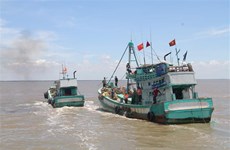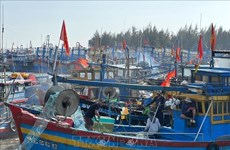Overall planning for Mekong Delta adjusted
Prime Minister Nguyen Tan Dung has approved adjustments to an overall
development planning for the Mekong Delta through 2030, with a vision
towards 2050.
Prime Minister Nguyen Tan Dung has approved adjustments to an overall
development planning for the Mekong Delta through 2030, with a vision
towards 2050.
The changes of the 2009 plan will be made across the whole region, which is constituted by Can Tho city and other 12 provinces, and covers a combined area of nearly 40,605 square kilometres. The region had a population around 17.3 million in 2013.
The adjusted planning is required to include analysis and assessment of the region’s natural conditions and resources, ecological areas, national parks and environmental preservation zones.
Impacts caused by climate change, rising sea level and floods, along with socio-economic development situation and infrastructure systems must be considered.
Forecasts for regional development, physical structure and growth models and new national and global developmental circumstances must be identified.
Meanwhile, environmental changes resulting from socio-economic development and climate change, and potential and momentums for regional development are to be counted.
Regional growth model should ensure the area is adapted to climate change and Mekong river floods.
Earlier, the Ministry of Planning and Investment announced a master plan for the Mekong Delta Economic Zone.
The zone, consisting of Can Tho and the three provinces of Ca Mau, An Giang and Kien Giang, will be developed into a large-scale tourism and service centre in Vietnam, focusing on expanding Nam Can national tourism area.
The Mekong delta is known as Vietnam’s largest granary and seafood depot with its rice and seafood outputs accounting for 53 percent and 60 percent of the country’s totals respectively.-VNA
The changes of the 2009 plan will be made across the whole region, which is constituted by Can Tho city and other 12 provinces, and covers a combined area of nearly 40,605 square kilometres. The region had a population around 17.3 million in 2013.
The adjusted planning is required to include analysis and assessment of the region’s natural conditions and resources, ecological areas, national parks and environmental preservation zones.
Impacts caused by climate change, rising sea level and floods, along with socio-economic development situation and infrastructure systems must be considered.
Forecasts for regional development, physical structure and growth models and new national and global developmental circumstances must be identified.
Meanwhile, environmental changes resulting from socio-economic development and climate change, and potential and momentums for regional development are to be counted.
Regional growth model should ensure the area is adapted to climate change and Mekong river floods.
Earlier, the Ministry of Planning and Investment announced a master plan for the Mekong Delta Economic Zone.
The zone, consisting of Can Tho and the three provinces of Ca Mau, An Giang and Kien Giang, will be developed into a large-scale tourism and service centre in Vietnam, focusing on expanding Nam Can national tourism area.
The Mekong delta is known as Vietnam’s largest granary and seafood depot with its rice and seafood outputs accounting for 53 percent and 60 percent of the country’s totals respectively.-VNA













